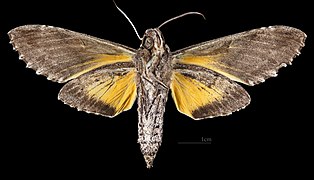
Manduca florestan, the Florestan sphinx, is a moth of the family Sphingidae. The species was first described by Caspar Stoll in 1782.
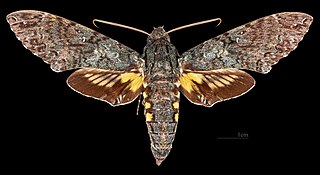
Amphonyx duponchel, or Duponchel's sphinx, is a moth of the family Sphingidae. The species was first described by Felipe Poey in 1832.

Manduca occulta, the occult sphinx, is a moth of the family Sphingidae.

Sphinx chersis, the great ash sphinx or northern ash sphinx, is a moth that belongs to the family Sphingidae.

Lintneria eremitus, the hermit sphinx, is a moth of the family Sphingidae. The species was first described by Jacob Hübner in 1823. It is found in the temperate areas of the eastern United States, north into southern Canada over the Great Plains. It prefers gardens and yards, but is common wherever the nectar and larval host plants are found. This moth is easily confused with the Canadian sphinx but these two moths do not typically co-occur.
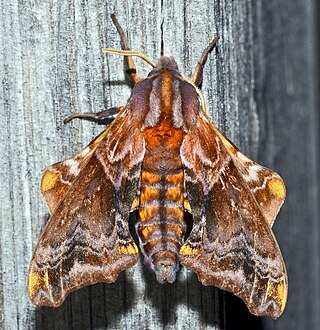
Paonias myops, the small-eyed sphinx, is a moth of the family Sphingidae. The species was first described by James Edward Smith in 1797.
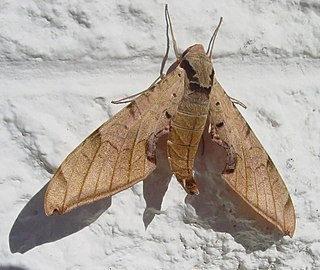
Protambulyx strigilis, the streaked sphinx, is a moth of the family Sphingidae prevalent in the Americas from Florida to Central and South America. The species was first described by Carl Linnaeus in 1771.
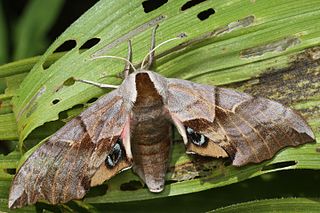
Smerinthus saliceti, the Salicet sphinx, is a moth of the family Sphingidae. The species was first described by Jean Baptiste Boisduval in 1875.

Erinnyis lassauxii, or Lassaux's sphinx, is a moth of the family Sphingidae.
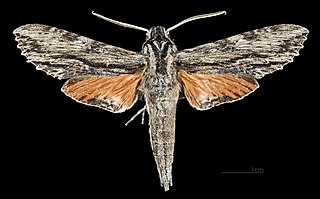
Erinnyis obscura, the obscure sphinx, is a moth of the family Sphingidae. The species was first described by Johann Christian Fabricius in 1775.

Perigonia lusca, the half-blind sphinx or coffee sphinx, is a moth of the family Sphingidae. It was first described by Johan Christian Fabricius in 1777.

Eumorpha satellitia, the satellite sphinx, is a moth of the family Sphingidae. The family was first described by Carl Linnaeus in 1771. It lives from Brazil and northern Argentina north through Central America, Mexico, and the West Indies to south Texas and southern Arizona.

Eumorpha vitis, known as the vine sphinx, is a moth of the family Sphingidae.

Manduca diffissa is a moth of the family Sphingidae first described by Arthur Gardiner Butler in 1871. It is known from most of South America.

Sphinx gordius, the apple sphinx, is a moth of the family Sphingidae. The species was first described by Pieter Cramer in 1780.

Pseudosphinx is a monotypic moth genus in the family Sphingidae first described by Hermann Burmeister in 1856. Its only species, Pseudosphinx tetrio, was first described by Carl Linnaeus in 1771. Its common names include tetrio sphinx, giant gray sphinx, frangipani hornworm, and plumeria caterpillar. In the island of Martinique it is best known as Rasta caterpillar because of its colors which are reminiscent of the ones found in Rastafarian clothing and accessories. It is native to the tropical and subtropical Americas from the southern and southwestern United States to Brazil. The occasional individual has been recorded as far north as the northeastern United States.
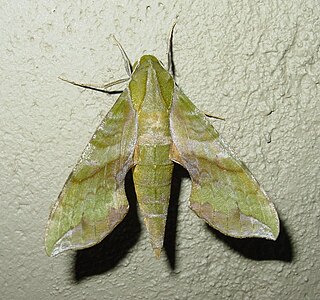
Xylophanes pluto, the Pluto sphinx, is a moth of the family Sphingidae. The species was first described by Johan Christian Fabricius in 1777.

Xylophanes porcus, the porcus sphinx, is a moth of the family Sphingidae. The family was first described by Jacob Hübner in 1823.

Isognathus australis is a moth of the family Sphingidae.
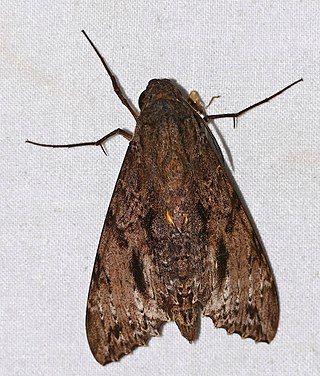
Isognathus swainsonii is a moth of the family Sphingidae.











